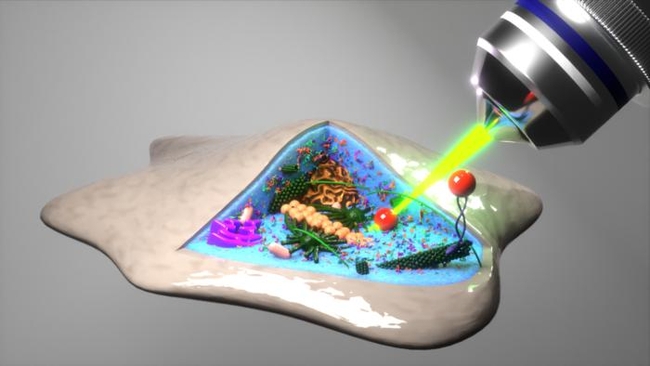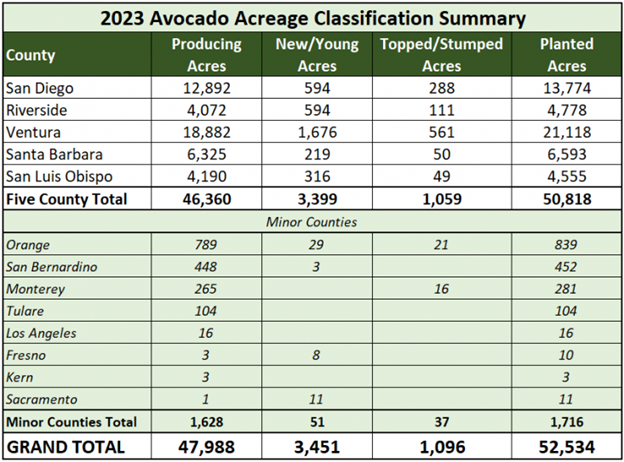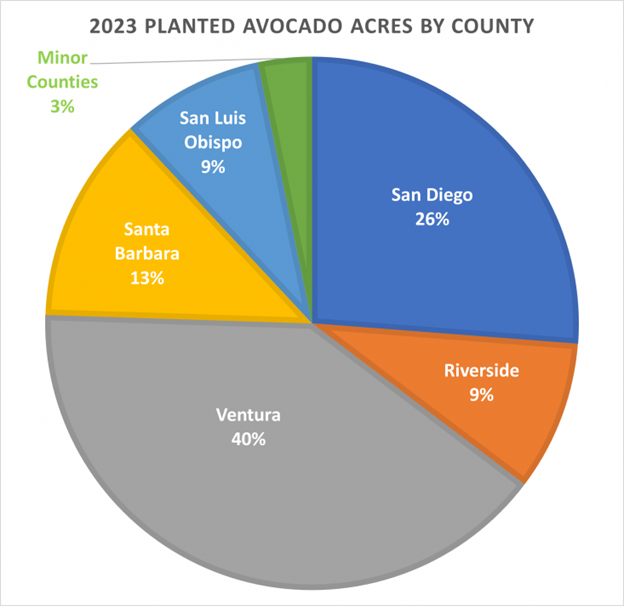Posts Tagged: avocado
Wild Fire and Soil
Low-severity wildland fires and prescribed burns have long been presumed by scientists and resource managers to be harmless to soils, but this may not be the case, new research shows.
According to two new studies by a team from the University of California, Merced (UCM) and the Desert Research Institute (DRI), low-severity burns - in which fire moves quickly and soil temperature does not exceed 250oC (482oF) - cause damage to soil structure and organic matter in ways that are not immediately apparent after a fire.
"When you have a high-severity fire, you burn off the organic matter from the soil and the impact is immediate," said Teamrat Ghezzehei, Ph.D., principal investigator of the two studies and Associate Professor of Environmental Soil Physics at UCM. "In a low-severity fire, the organic matter doesn't burn off, and there is no visible destruction right away. But the burning weakens the soil structure, and unless you come back at a later time and carefully look at the soil, you wouldn't notice the damage."
DRI researcher Markus Berli, Ph.D., Associate Research Professor of Environmental Science, became interested in studying this phenomenon while visiting a burned area near Ely, Nev. in 2009, where he made the unexpected observation that a prescribed, low-severity fire had resulted in soil structure damage in the burned area. He and several colleagues from DRI conducted a follow-up study on another controlled burn in the area, and found that soil structure that appeared to be fine immediately after a fire but deteriorated over the weeks and months that followed. Berli then teamed up with Ghezzehei and a team from UCM that included graduate student Mathew Jian, and Associate Professor Asmeret Asefaw Berhe, Ph.D., to further investigate.
Soil consists of large and small mineral particles (gravel, sand, silt, and clay) which are bound together by organic matter, water and other materials to form aggregates. When soil aggregates are exposed to severe fires, the organic matter burns, altering the physical structure of the soil and increasing the risk of erosion in burned areas. In low-severity burn areas where organic matter doesn't experience significant losses, the team wondered if the soil structure was being degraded by another process, such as by the boiling of water held within soil aggregates?
In a study published in AGU Geophysical Research Letters in May 2018, the UCM-DRI team investigated this question, using soil samples from an unburned forest area in Mariposa County, Calif. and from unburned shrubland in Clark County, Nev. to analyze the impacts of low-severity fires on soil structure. They heated soil aggregates to temperatures that simulated the conditions of a low-severity fire (175oC/347oF) over a 15-minute period, then looked for changes in the soil's internal pore pressure and tensile strength (the force required to pull the aggregate apart).
During the experiment, they observed that pore pressure within the soil aggregates rose to a peak as water boiled and vaporized, then dropped as the bonds in the soil aggregates broke and vapor escaped. Tensile strength measurements showed that the wetter soil aggregates had been weakened more than drier soil samples during this process.
"Our results show that the heat produced by low-severity fires is actually enough to do damage to soil structure, and that the damage is worse if the soils are wet," Berli explained. "This is important information for resource managers because it implies that prescribed burns and other fires that occur during wetter times of year may be more harmful to soils than fires that occur during dry times."Next, the research team wondered what the impact of this structural degradation was on the organic matter that the soil structure normally protects. Soil organic matter consists primarily of microbes and decomposing plant tissue, and contributes to the overall stability and water-holding capacity of soils.
In a second study that was published in Frontiers in Environmental Science in late July, the UCM-DRI research team conducted simulated burn experiments to weaken the structure of the soil aggregates, and tested the soils for changes in quality and quantity of several types of organic matter over a 70-day period.
They found that heating of soils led to the release of organic carbon into the atmosphere as CO2 during the weeks and months after the fire, and again found that the highest levels of degradation occurred in soils that were moist. This loss of organic carbon is important for several reasons, Ghezzehei explained.
"The loss of organic matter from soil to the atmosphere directly contributes to climate change, because that carbon is released as CO2," Ghezzehei said. "Organic matter that is lost due to fires is also the most important reserve of nutrients for soil micro-organisms, and it is the glue that holds soil aggregates together. Once you lose the structure, there are a lot of other things that happen. For example, infiltration becomes slower, you get more runoff, you have erosion."
Although the research team's findings showed several detrimental effects of fire on soils, low-severity wildfires and prescribed burns are known to benefit ecosystems in other ways -- recycling nutrients back into the soil and getting rid of overgrown vegetation, for example. It is not yet clear whether the negative impacts on soil associated with these low-severity fires outweigh the positives, Berli says, but the team hopes that their research results will help to inform land managers as they manage wildfires and plan prescribed burns.
"There is very little fuel in arid and semi-arid areas, and thus fires tend to be short lived and relatively low in peak temperature," Ghezzehei said. "In contrast to the hot fires and that burn for days and weeks that we see in the news, these seem to be benign and we usually treat them as such. Our work shows that low-severity fires are not as harmless as they may appear."
The study, "Soil Structural Degradation During Low?Severity Burns," was published on May 31, 2018 in the journal AGU Geophysical Research Letters and is available here: https:/
The study, "Vulnerability of Physically Protected Soil Organic Carbon to Loss Under Low Severity Fires," was published July 19, 2018 in the journal Frontiers in Environmental Science, and is available here: https:/

IMG 2031
Now is NOT the Time to Prune Avocados
When to Prune Avocados and Suggestions of How to Prune
In the past avocados were rarely pruned. In fact, if the trees got very big, growers would stump them down to 3-4 feet and then let them regrow. This would often be a disaster, since the trees rapidly grew to stupendous sizes again. They also might regrow then suddenly collapse, because all that regrowth was coming at the expense of energy being sent to the roots. If the roots were compromised by root rot, they would then not have the energy to fend off the disease. So, by bringing the canopy into balance with a sick root system that was continuing to die and was not being fed by a big canopy, the root death would accelerate and when the canopy and root system became imbalanced again, the whole canopy would collapse, and the tree would die.
Also, this wild regrowth was wild and hard to manage. The adage of “prune avocado trees cautiously” was heard round the avocado community and as a result many growers would not do anything. The trees growing larger and larger and larger with the fruiting canopy going higher and higher and higher and picking costs and liability going up. Tree thinning was practiced, where every other tree would be removed so that light could penetrate into the orchard, encouraging more fruit production and slowing tree growth. But they would still grow, and another thinning would be needed. The original commercial ‘Hass' orchard in Carpinteria started out in 1954 with 140 trees and 40 years later was down to 17 trees and was still productive, but they were monsters that were finally felled by root rot.
Many commercial avocados are now routinely pruned to keep the trees short, so that harvesting costs and other tree maintenance expenses are reduced. Also, more light shines into the trees, so that more fruit is borne on the lower branches. Light or minor pruning can be done any time of year to correct imbalances or limb breakages. However, major or heavy pruning should only be done in the early part of the year from January through April. Fall or early winter pruning can open up the canopy so that it is more prone to frost damage. The closed canopy holds in the heat better.
The major reason not to prune in fall and early winter is that a perennial, evergreen subtropical like avocado goes into a quiescent stage during the fall in preparation for winter cold. The tree does not go dormant like an apple or peach but goes into a metabolic state that can better handle cold. By pruning in the fall, the tree becomes actively metabolic and more prone to frost damage. The tree needs to slow down to better handle the cold.
Avocados flower and bear fruit at stem terminals, so if you give the tree and buzz cut (heading cuts), all the flower terminals will be cut off and there will be no flowering the following year. It also leads to an explosion of water sprouts that result from bud break up and down the branch because the terminal bud which controls the buds lower down have been removed. Naphthalene acetic acid (Tre-Hold) painted on the cut end can be used to restrict some of this wild bud break.
Whenever possible, thinning cuts should be made, where the branch is removed back to a subtending branch. This results in much less wild growth. Also, when there are buds that start growing into water sprouts, they can be nipped back to force lateral growth. These laterals will then slow down the growth of the sprout and the side terminal buds will also be able to grow and transition of flower buds later.
Work in Carol Lovatt's lab at UCR has shown that terminal buds need a certain maturity to flower and the transition from a vegetative bud to a flowering bud occurs sometime in late summer/early fall. If pruning is done in July, there is not enough time for the new buds to mature by August and there will be no flowers from that branch the following spring. New vegetative buds formed on growth from spring will often have enough maturation time to make the transition to flower buds, resulting in flowering the next spring.
Any major pruning done in later spring and summer is also going to require some protection for the remaining scaffolds from sunburn. Get ready to paint the scaffold with dilute latex paint to protect the once protected bark from sunburn damage. This can pretty rapidly kill the underlying cambium within days if it heats up newly exposed wood.
Again, light pruning can be done at any time of the year, but removing terminals is removing potential fruiting wood. Therefore, if heavy pruning is needed, it is best to remove one branch at a time. To reduce the height of a tree, cut out the tallest branch one year, the next tallest branch the following year, and so on until the tree is down to the height required. The process may take three to four years. By reducing the height over several years, the tree is put under less stress, less disease is likely to occur and fruit production is not drastically reduced. Pruning the sides of the tree should be done in the same way. Prune off a side branch that most impinges on a neighboring tree one year, then the next worst offender in the second year, and over the years continue this process until there is light all around the tree.
If pruning creates major open areas in the tree to sunlight where there once was shade, the exposed branches should be painted with white latex paint diluted with water so that it can be sprayed on. It needs to be white enough that it can reflect sunlight and avoid heat damage that can cause sunburn. Sunburn can utterly destroy all the work that has been done.
If the trees are really monsters, the only real alternative is to bring the whole tree down. But not stumping, rather scaffolding where much of the structure is maintained. This is where the tree is brought down to as high a height as is convenient and safe. By cutting the tree to a height of 8 feet or so, there is not so much rank regrowth because a greater portion of the tree is retained. Also, many times there are leafy branches that remain that will flower and fruit and slow the wild regrowth. Water sprouts that form should be headed back to force lateral growth that encourages stems that will flower, which will also slow the wild regrowth.
And one last warning. Do not. Do not. Do not. Got it? Prune sick trees. If the roots are compromised, the regrowth is going to be hard on the roots. Get the trees perked up with one of the phosphite products so that they are ready to go through this process. You may have to wait a couple years to start the pruning process until the trees are in shape for the rigors.
In summary: Late winter to early spring is the sweet spot for pruning your avocado trees. This timing is key because it sidesteps the risk of cold damage and aligns with the tree's natural flowering cycle. Pruning too late can lead to sunburned branches and a reduced fruit set the following year.
Image: Don't make cuts like this. Those stubs or going to create a royal mess of new, wild growth.
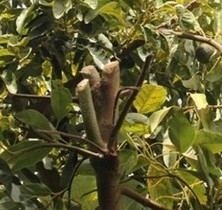
avocado pruning stub 1
Inside the Avocado
A new way of looking at plant nutrition? Frost damage? Disease? Heat damage?
"Laser view" into the avocado: New method reveals cell interior
Research team at the University of Göttingen develops method for recognizing cell properties
Checking whether an avocado is hard or soft by looking at it? This would require recognizing how the plant cells behave behind the skin. The same applies to all other cells on our planet: Despite more than 100 years of intensive research, many of their properties remain hidden inside the cell. Researchers at the University of Göttingen describe in their recent publication in Nature Materials a new approach that can determine the particularly difficult-to-detect mechanical properties of the cell interior by taking a closer look.
Cells are the basic units of all life and their precise understanding is a key factor in the progress made in medicine and biology. Nevertheless, research on them is still challenging because many methods destroy the cell during analysis. Researchers at the University of Göttingen now pursued a new idea: they used the random fluctuating movement that all microscopic particles perform. To do this, they first simulated the expected fluctuations and then checked the predictions using optical laser traps that can precisely control microparticles. Using this approach, the research team was able to analyze the movement of microscopic particles – with precision in the nanometer range and a time resolution of around 50 microseconds. In addition, the analysis also takes into account the history, i.e. past movements. It turned out that many objects always want to return to a certain place after having moved away randomly. The researchers used this tendency to return to a previous position to define a new quantify, the so-called mean back relaxation (MBR).
This new variable now serves as a kind of fingerprint: it contains information about the causes of the observed movements. This makes it possible for the first time to distinguish active processes from purely temperature-dependent processes (Brownian motion). "With MBR, we can obtain more information from the object movements than is possible with the usual approaches," explains Professor Matthias Krüger from the Institute of Theoretical Physics at the University of Göttingen.
In order to make statements about living cells, the researchers applied the method to the inside of living cells. "As our knowledge of the inside of cells is still limited, it was initially unclear whether the MBR could also be used here. When I saw the resulting curves, I could hardly believe my eyes, because the inside of cells could be described very precisely using the approaches we had originally worked out for much simpler situations ," marvels Professor Timo Betz from the Third Institute of Physics, head of the experiments.
"The results show that the combination of a close look and new, intelligent analysis methods can provide insights into whether the inside of cells is soft, hard or liquid," says first author of the study, Till Münker from the Third Institute of Physics. The work was co-funded by the European Union as part of an ERC Consolidator Grant.
Original publication: Münker, T. M. et al. Accessing activity and viscoelastic properties of artificial and living systems from passive measurement. Nature Materials 2024. Doi: 10.1038/s41563-024-01957-2.

avocado pit
CA Avocado Acreage
Each year the California Avocado Commission partners with Land IQ to produce a Statewide Avocado Acreage and Condition Analysis report utilizing digital satellite imagery, aerial photography and analytical tools to survey California avocado groves. This data helps the Commission make informed budgeting and marketing decisions and provides industry members with spatial data concerning crop type, location, condition and density. See the full 2023 Report HERE.
According to the report:
- In 2023 there were 52,534 planted avocado acres
- The majority of growing acreage is located in Ventura, San Diego, Santa Barbara, Riverside and San Luis Obispo Counties with a total of 50,818 planted acres
- The five top-producing counties reported 1,059 new/young acres and 3,399 topped/stumped acres
The report also provides acreage data by zip code, county, condition, year planted and density.
The California Avocado Commission's crop estimating team in conjunction with Land IQ uses the latest in remote sensing techniques to assess avocado acreage in production. As technology continues to advance refinements in our fourth generation of remote sensing techniques were applied to satellite imagery collected during spring and summer months. The imagery processing techniques include; segmentation into homogenous polygons, retention of tree crop polygons, calculation of average crop canopy moisture and vegetation indices, analysis of change maps from previous inventories, and classification of avocado groves into four categories; producing, topped/stumped, new/young, and abandoned. Aerial imagery (for a real-world view), and satellite imagery (for spectral and temporal data) are integrated into previously classified avocado acreage and analyzed for current condition of California avocado acreage statewide.
from CA Ag Net: https://californiaagnet.com/2024/07/29/california-avocado-acreage-increases-2023-report-available/

avocado berms
Avocado Lace Bug Spreads
There has been a recent expansion of Avocado Lace Bug into parts of the Carpinteria area. It was more or less located in the San Diego coastal area. It spreads mainly with people.......
Read about it at the UC-IPM website and the observations of Mark Hoddle, IPM Specialist at UC Riverside.
https://ipm.ucanr.edu/agriculture/avocado/avocado-lace-bug/#gsc.tab=0
- ALB does better in the slightly cooler more humid orchards in Oceanside when compared to the hotter inland Bonsall orchards.
- In the lab, under a fluctuating 24 hr temperate cycle similar to an avocado orchard in Escondido, optimal temps for development are a daily average of around 31-32oC (88-90oF)
- ALB life stage densities tend to be greater on leaves over June-Oct
- % leaf infestation measures (i.e., the proportion of sampled leaves with ALB lifestages) tend to be peak over fall-winter (Sept-Feb), but ALB densities on leaves are not as high as what are seen over June-Oct, there are basically more leaves with ALB and those per leaf densities are lower that numbers counted over June-Oct.
- Its hard to predict what the next season's ALB will be as lots of ALB are shed when leaves drop, but like persea mite, some manage to get back onto the new leaves to start the next round of infestations. Adults don't seem to be very flighty, well, at least they don't seem to exhibit mass flight activity that would suggest searching for new hosts as leaves deteriorate.
Keep your eyes open for a future edition of the CA Avocado Commission's magazine - From The Grove - for a more thorough discussion of the pest.
https://www.californiaavocadogrowers.com/publications/from-the-grove
images:
Adult
Adults, young, and fecal pellets
Leaf damage
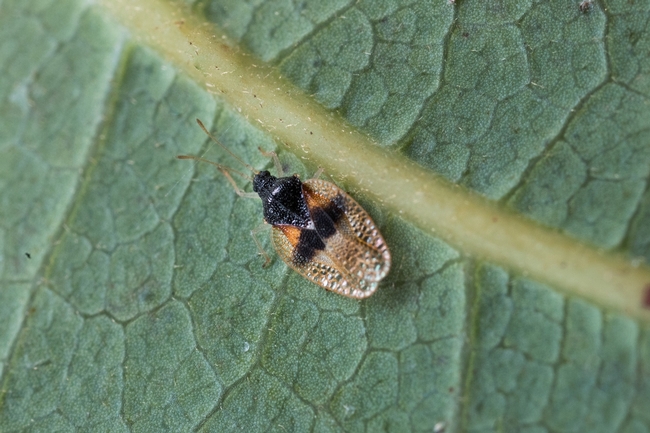
ALB-Low-Res

avocado lace bug
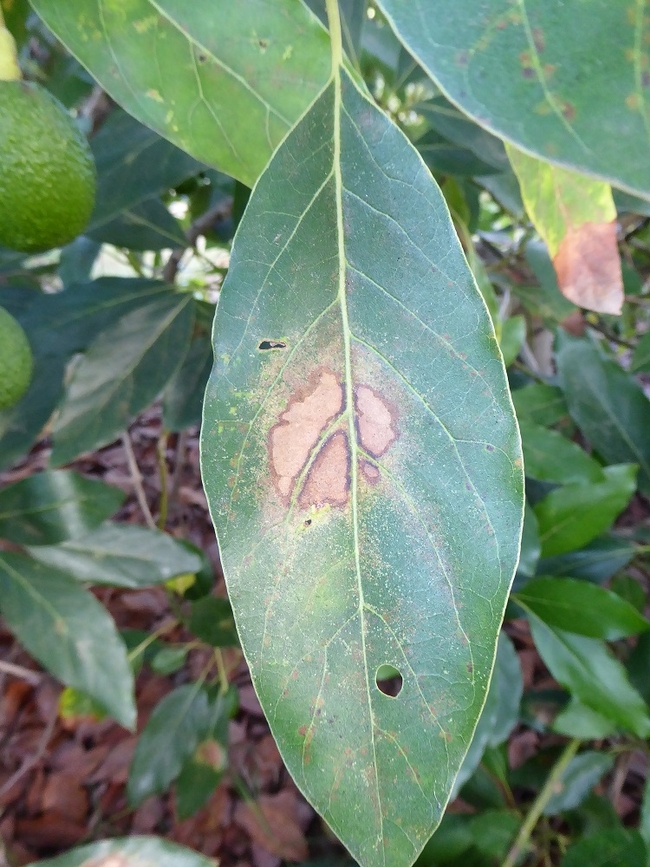
ALB-Leaf-Damage-Low-Res

